Criminal Justice System: Analysis of Aboriginal Issues in Canada
VerifiedAdded on 2023/01/23
|9
|2568
|54
Report
AI Summary
This report analyzes three key aspects of the Canadian criminal justice system related to Aboriginal peoples. It begins by examining the wrongful conviction of Donald Marshall, Jr., detailing the failures within the criminal justice system that led to his 11-year imprisonment and exploring the evidence of systemic racism. The report then investigates the traditional roles of Aboriginal women before European contact and how European settlement impacted their position within their communities, discussing the effects on their interactions with the criminal justice system. Finally, the report explores the origins and lasting effects of the residential school system on Aboriginal children, parents, and communities, considering its contribution to the over-representation of Aboriginal peoples in the criminal justice system. The report uses the Donald Marshall case to show how the criminal justice system failed and the lasting impact of the residential schools.
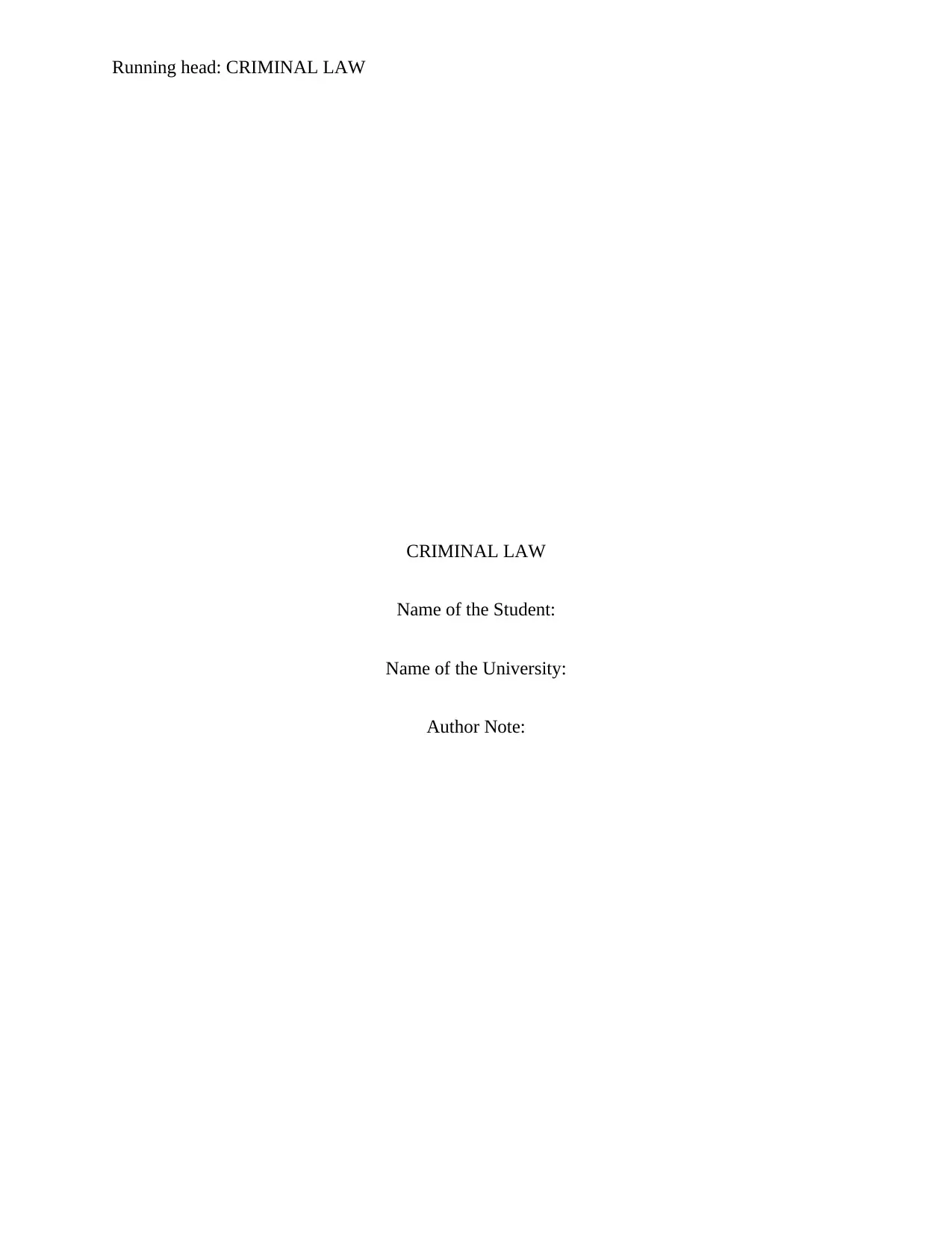
Running head: CRIMINAL LAW
CRIMINAL LAW
Name of the Student:
Name of the University:
Author Note:
CRIMINAL LAW
Name of the Student:
Name of the University:
Author Note:
Paraphrase This Document
Need a fresh take? Get an instant paraphrase of this document with our AI Paraphraser
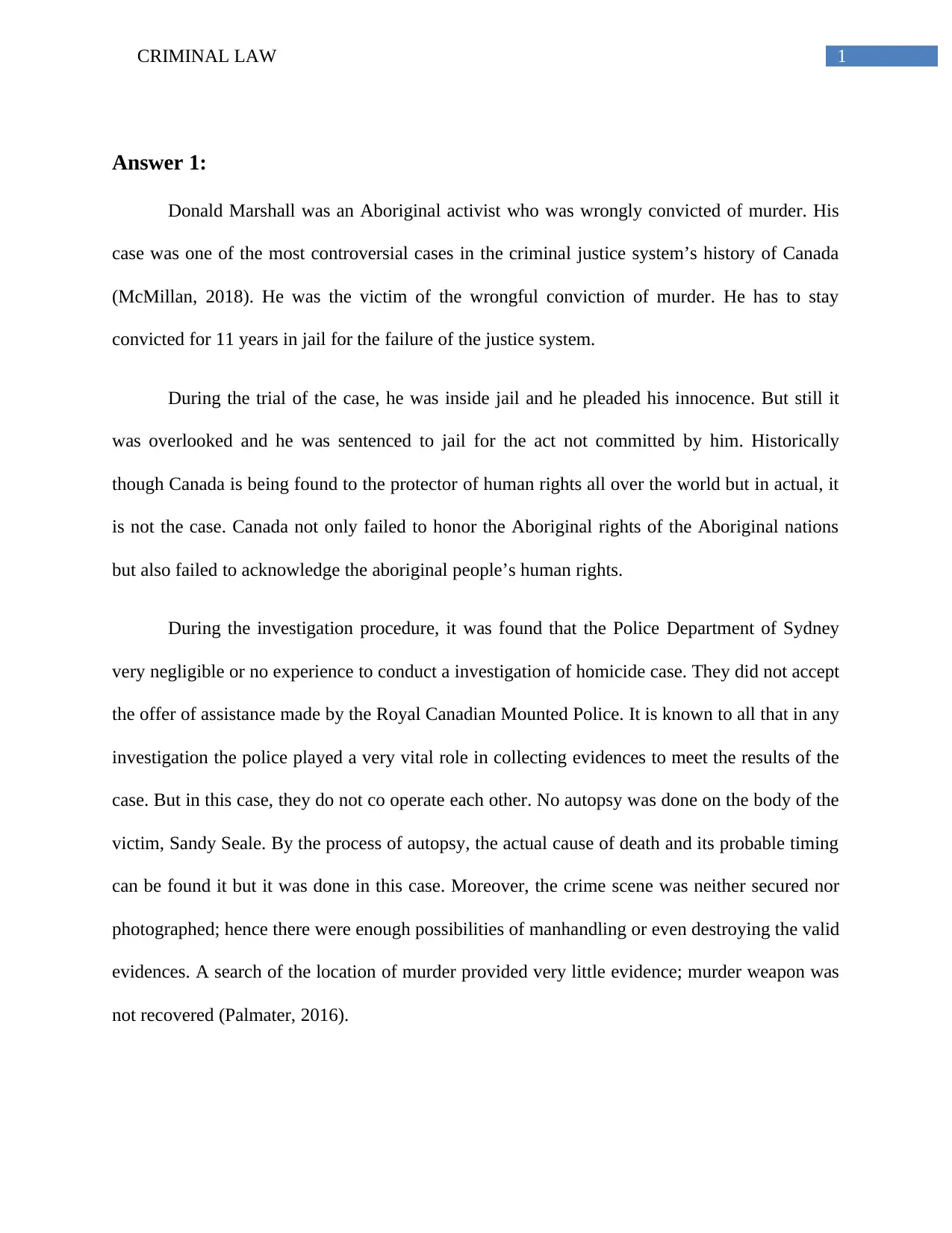
1CRIMINAL LAW
Answer 1:
Donald Marshall was an Aboriginal activist who was wrongly convicted of murder. His
case was one of the most controversial cases in the criminal justice system’s history of Canada
(McMillan, 2018). He was the victim of the wrongful conviction of murder. He has to stay
convicted for 11 years in jail for the failure of the justice system.
During the trial of the case, he was inside jail and he pleaded his innocence. But still it
was overlooked and he was sentenced to jail for the act not committed by him. Historically
though Canada is being found to the protector of human rights all over the world but in actual, it
is not the case. Canada not only failed to honor the Aboriginal rights of the Aboriginal nations
but also failed to acknowledge the aboriginal people’s human rights.
During the investigation procedure, it was found that the Police Department of Sydney
very negligible or no experience to conduct a investigation of homicide case. They did not accept
the offer of assistance made by the Royal Canadian Mounted Police. It is known to all that in any
investigation the police played a very vital role in collecting evidences to meet the results of the
case. But in this case, they do not co operate each other. No autopsy was done on the body of the
victim, Sandy Seale. By the process of autopsy, the actual cause of death and its probable timing
can be found it but it was done in this case. Moreover, the crime scene was neither secured nor
photographed; hence there were enough possibilities of manhandling or even destroying the valid
evidences. A search of the location of murder provided very little evidence; murder weapon was
not recovered (Palmater, 2016).
Answer 1:
Donald Marshall was an Aboriginal activist who was wrongly convicted of murder. His
case was one of the most controversial cases in the criminal justice system’s history of Canada
(McMillan, 2018). He was the victim of the wrongful conviction of murder. He has to stay
convicted for 11 years in jail for the failure of the justice system.
During the trial of the case, he was inside jail and he pleaded his innocence. But still it
was overlooked and he was sentenced to jail for the act not committed by him. Historically
though Canada is being found to the protector of human rights all over the world but in actual, it
is not the case. Canada not only failed to honor the Aboriginal rights of the Aboriginal nations
but also failed to acknowledge the aboriginal people’s human rights.
During the investigation procedure, it was found that the Police Department of Sydney
very negligible or no experience to conduct a investigation of homicide case. They did not accept
the offer of assistance made by the Royal Canadian Mounted Police. It is known to all that in any
investigation the police played a very vital role in collecting evidences to meet the results of the
case. But in this case, they do not co operate each other. No autopsy was done on the body of the
victim, Sandy Seale. By the process of autopsy, the actual cause of death and its probable timing
can be found it but it was done in this case. Moreover, the crime scene was neither secured nor
photographed; hence there were enough possibilities of manhandling or even destroying the valid
evidences. A search of the location of murder provided very little evidence; murder weapon was
not recovered (Palmater, 2016).
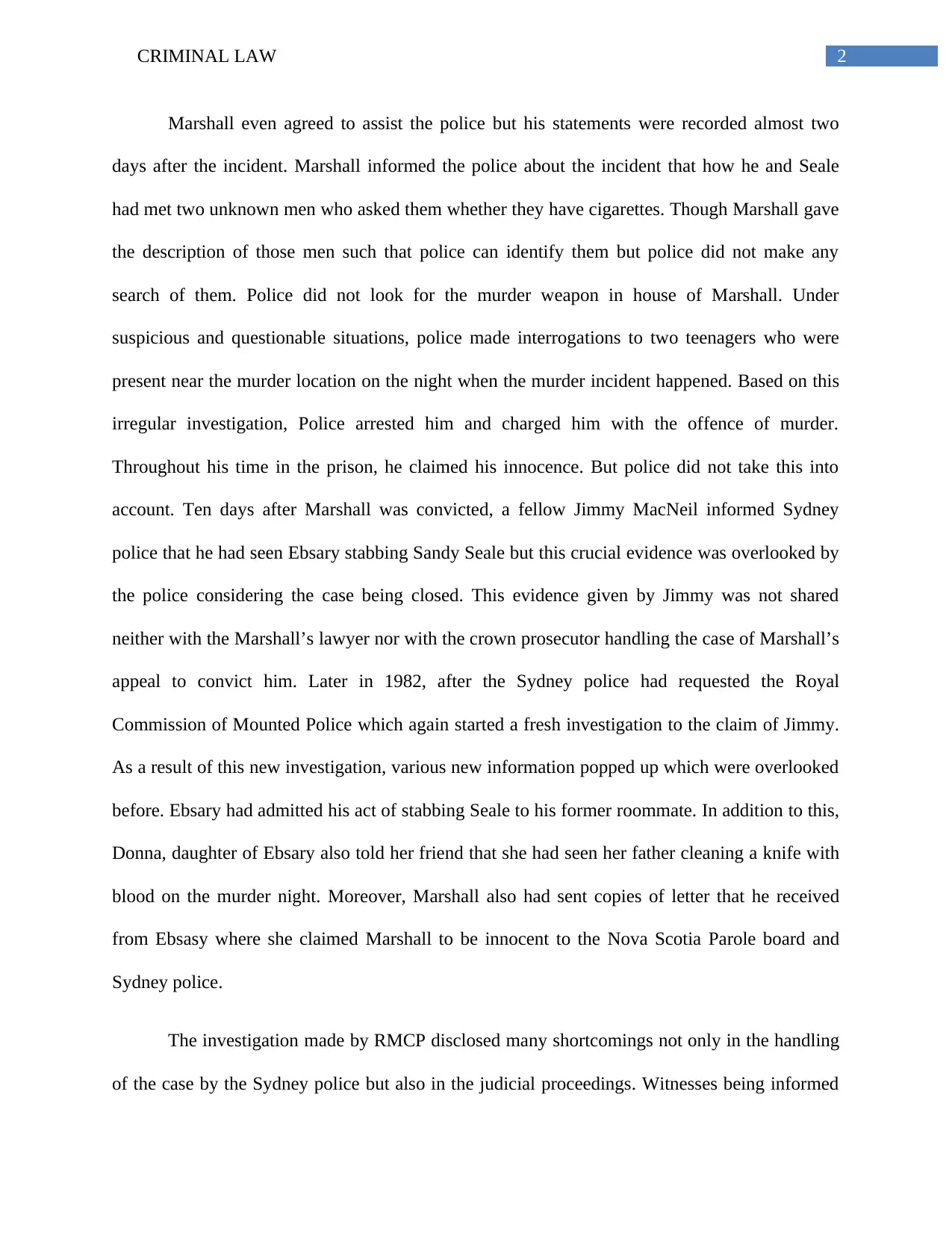
2CRIMINAL LAW
Marshall even agreed to assist the police but his statements were recorded almost two
days after the incident. Marshall informed the police about the incident that how he and Seale
had met two unknown men who asked them whether they have cigarettes. Though Marshall gave
the description of those men such that police can identify them but police did not make any
search of them. Police did not look for the murder weapon in house of Marshall. Under
suspicious and questionable situations, police made interrogations to two teenagers who were
present near the murder location on the night when the murder incident happened. Based on this
irregular investigation, Police arrested him and charged him with the offence of murder.
Throughout his time in the prison, he claimed his innocence. But police did not take this into
account. Ten days after Marshall was convicted, a fellow Jimmy MacNeil informed Sydney
police that he had seen Ebsary stabbing Sandy Seale but this crucial evidence was overlooked by
the police considering the case being closed. This evidence given by Jimmy was not shared
neither with the Marshall’s lawyer nor with the crown prosecutor handling the case of Marshall’s
appeal to convict him. Later in 1982, after the Sydney police had requested the Royal
Commission of Mounted Police which again started a fresh investigation to the claim of Jimmy.
As a result of this new investigation, various new information popped up which were overlooked
before. Ebsary had admitted his act of stabbing Seale to his former roommate. In addition to this,
Donna, daughter of Ebsary also told her friend that she had seen her father cleaning a knife with
blood on the murder night. Moreover, Marshall also had sent copies of letter that he received
from Ebsasy where she claimed Marshall to be innocent to the Nova Scotia Parole board and
Sydney police.
The investigation made by RMCP disclosed many shortcomings not only in the handling
of the case by the Sydney police but also in the judicial proceedings. Witnesses being informed
Marshall even agreed to assist the police but his statements were recorded almost two
days after the incident. Marshall informed the police about the incident that how he and Seale
had met two unknown men who asked them whether they have cigarettes. Though Marshall gave
the description of those men such that police can identify them but police did not make any
search of them. Police did not look for the murder weapon in house of Marshall. Under
suspicious and questionable situations, police made interrogations to two teenagers who were
present near the murder location on the night when the murder incident happened. Based on this
irregular investigation, Police arrested him and charged him with the offence of murder.
Throughout his time in the prison, he claimed his innocence. But police did not take this into
account. Ten days after Marshall was convicted, a fellow Jimmy MacNeil informed Sydney
police that he had seen Ebsary stabbing Sandy Seale but this crucial evidence was overlooked by
the police considering the case being closed. This evidence given by Jimmy was not shared
neither with the Marshall’s lawyer nor with the crown prosecutor handling the case of Marshall’s
appeal to convict him. Later in 1982, after the Sydney police had requested the Royal
Commission of Mounted Police which again started a fresh investigation to the claim of Jimmy.
As a result of this new investigation, various new information popped up which were overlooked
before. Ebsary had admitted his act of stabbing Seale to his former roommate. In addition to this,
Donna, daughter of Ebsary also told her friend that she had seen her father cleaning a knife with
blood on the murder night. Moreover, Marshall also had sent copies of letter that he received
from Ebsasy where she claimed Marshall to be innocent to the Nova Scotia Parole board and
Sydney police.
The investigation made by RMCP disclosed many shortcomings not only in the handling
of the case by the Sydney police but also in the judicial proceedings. Witnesses being informed
⊘ This is a preview!⊘
Do you want full access?
Subscribe today to unlock all pages.

Trusted by 1+ million students worldwide
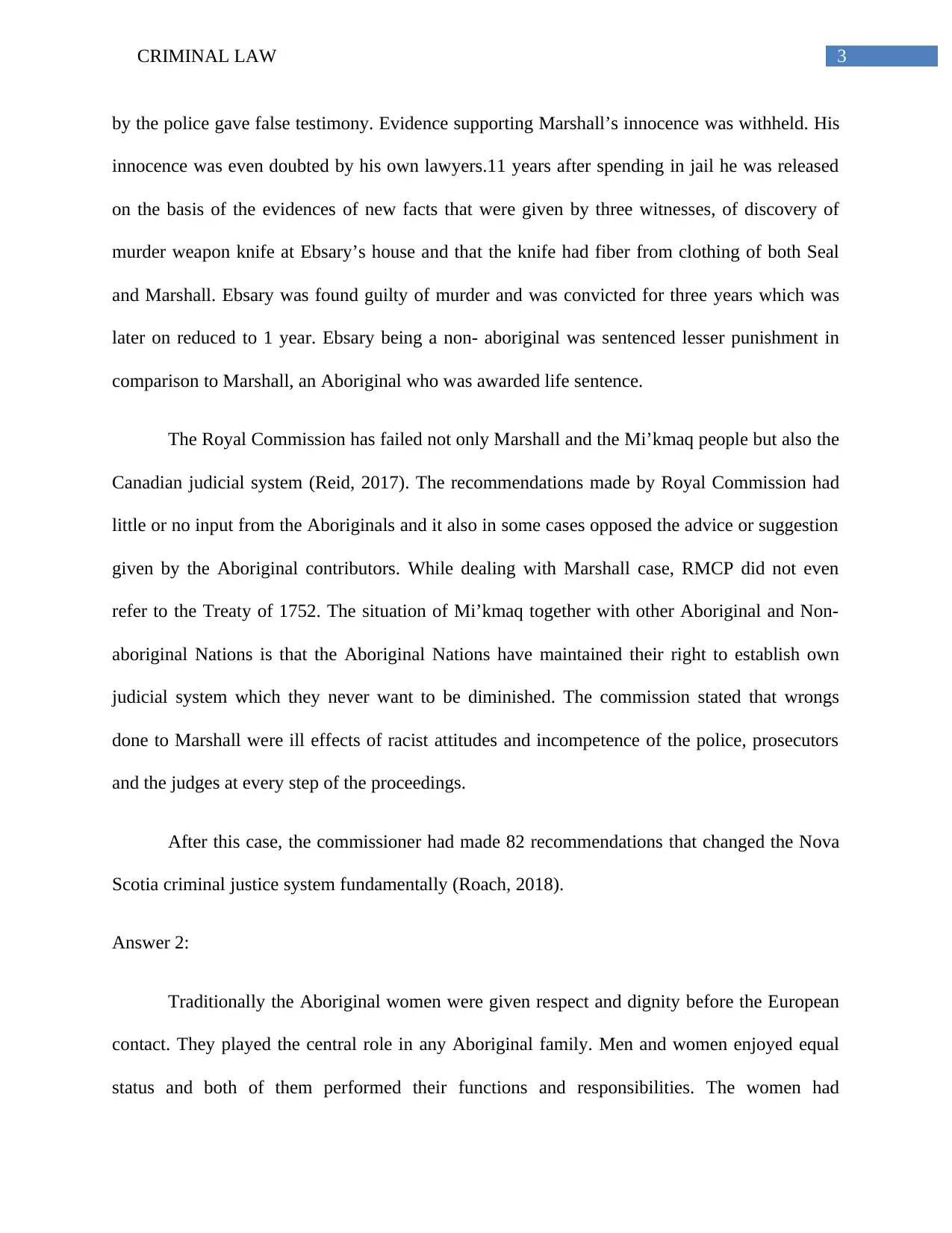
3CRIMINAL LAW
by the police gave false testimony. Evidence supporting Marshall’s innocence was withheld. His
innocence was even doubted by his own lawyers.11 years after spending in jail he was released
on the basis of the evidences of new facts that were given by three witnesses, of discovery of
murder weapon knife at Ebsary’s house and that the knife had fiber from clothing of both Seal
and Marshall. Ebsary was found guilty of murder and was convicted for three years which was
later on reduced to 1 year. Ebsary being a non- aboriginal was sentenced lesser punishment in
comparison to Marshall, an Aboriginal who was awarded life sentence.
The Royal Commission has failed not only Marshall and the Mi’kmaq people but also the
Canadian judicial system (Reid, 2017). The recommendations made by Royal Commission had
little or no input from the Aboriginals and it also in some cases opposed the advice or suggestion
given by the Aboriginal contributors. While dealing with Marshall case, RMCP did not even
refer to the Treaty of 1752. The situation of Mi’kmaq together with other Aboriginal and Non-
aboriginal Nations is that the Aboriginal Nations have maintained their right to establish own
judicial system which they never want to be diminished. The commission stated that wrongs
done to Marshall were ill effects of racist attitudes and incompetence of the police, prosecutors
and the judges at every step of the proceedings.
After this case, the commissioner had made 82 recommendations that changed the Nova
Scotia criminal justice system fundamentally (Roach, 2018).
Answer 2:
Traditionally the Aboriginal women were given respect and dignity before the European
contact. They played the central role in any Aboriginal family. Men and women enjoyed equal
status and both of them performed their functions and responsibilities. The women had
by the police gave false testimony. Evidence supporting Marshall’s innocence was withheld. His
innocence was even doubted by his own lawyers.11 years after spending in jail he was released
on the basis of the evidences of new facts that were given by three witnesses, of discovery of
murder weapon knife at Ebsary’s house and that the knife had fiber from clothing of both Seal
and Marshall. Ebsary was found guilty of murder and was convicted for three years which was
later on reduced to 1 year. Ebsary being a non- aboriginal was sentenced lesser punishment in
comparison to Marshall, an Aboriginal who was awarded life sentence.
The Royal Commission has failed not only Marshall and the Mi’kmaq people but also the
Canadian judicial system (Reid, 2017). The recommendations made by Royal Commission had
little or no input from the Aboriginals and it also in some cases opposed the advice or suggestion
given by the Aboriginal contributors. While dealing with Marshall case, RMCP did not even
refer to the Treaty of 1752. The situation of Mi’kmaq together with other Aboriginal and Non-
aboriginal Nations is that the Aboriginal Nations have maintained their right to establish own
judicial system which they never want to be diminished. The commission stated that wrongs
done to Marshall were ill effects of racist attitudes and incompetence of the police, prosecutors
and the judges at every step of the proceedings.
After this case, the commissioner had made 82 recommendations that changed the Nova
Scotia criminal justice system fundamentally (Roach, 2018).
Answer 2:
Traditionally the Aboriginal women were given respect and dignity before the European
contact. They played the central role in any Aboriginal family. Men and women enjoyed equal
status and both of them performed their functions and responsibilities. The women had
Paraphrase This Document
Need a fresh take? Get an instant paraphrase of this document with our AI Paraphraser
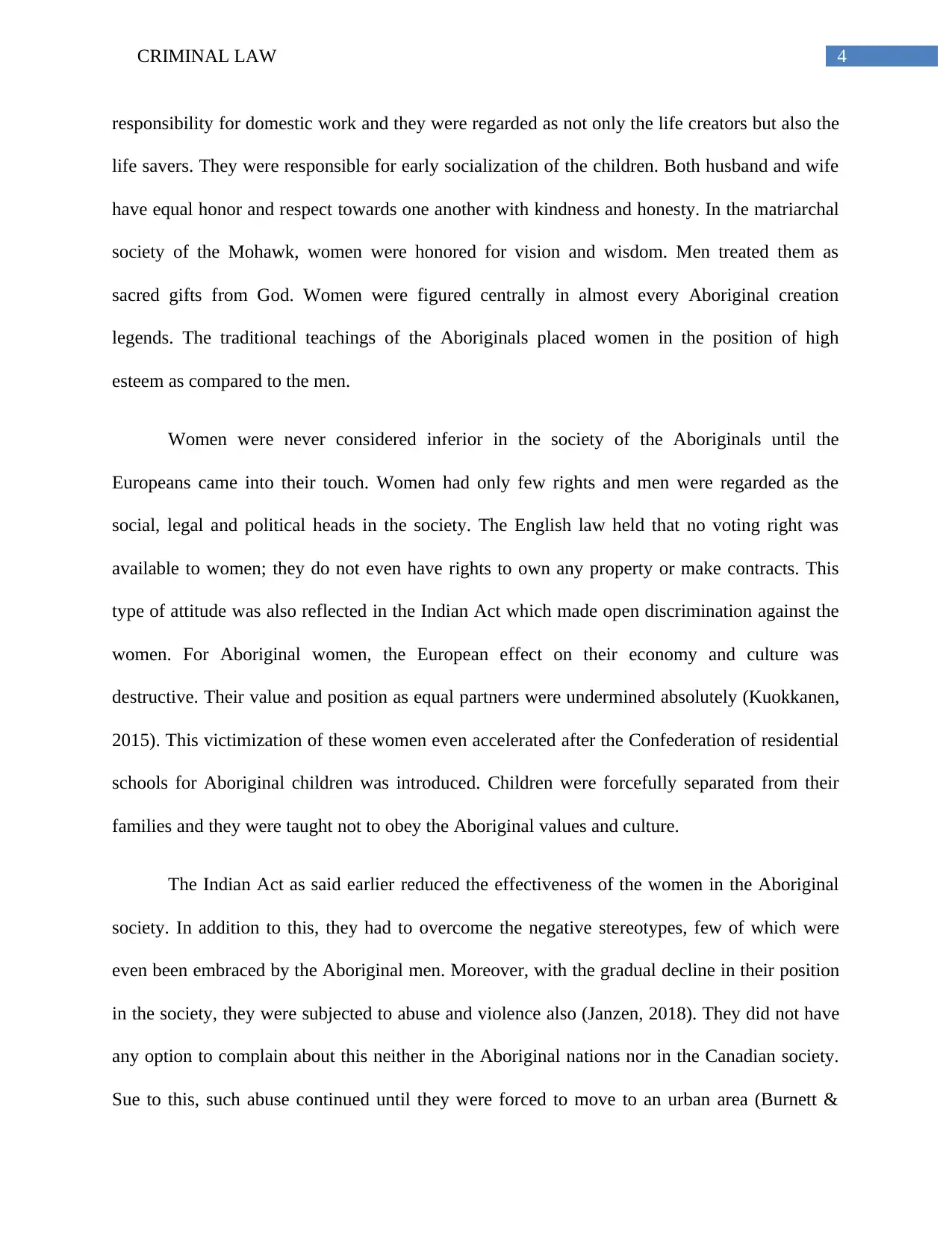
4CRIMINAL LAW
responsibility for domestic work and they were regarded as not only the life creators but also the
life savers. They were responsible for early socialization of the children. Both husband and wife
have equal honor and respect towards one another with kindness and honesty. In the matriarchal
society of the Mohawk, women were honored for vision and wisdom. Men treated them as
sacred gifts from God. Women were figured centrally in almost every Aboriginal creation
legends. The traditional teachings of the Aboriginals placed women in the position of high
esteem as compared to the men.
Women were never considered inferior in the society of the Aboriginals until the
Europeans came into their touch. Women had only few rights and men were regarded as the
social, legal and political heads in the society. The English law held that no voting right was
available to women; they do not even have rights to own any property or make contracts. This
type of attitude was also reflected in the Indian Act which made open discrimination against the
women. For Aboriginal women, the European effect on their economy and culture was
destructive. Their value and position as equal partners were undermined absolutely (Kuokkanen,
2015). This victimization of these women even accelerated after the Confederation of residential
schools for Aboriginal children was introduced. Children were forcefully separated from their
families and they were taught not to obey the Aboriginal values and culture.
The Indian Act as said earlier reduced the effectiveness of the women in the Aboriginal
society. In addition to this, they had to overcome the negative stereotypes, few of which were
even been embraced by the Aboriginal men. Moreover, with the gradual decline in their position
in the society, they were subjected to abuse and violence also (Janzen, 2018). They did not have
any option to complain about this neither in the Aboriginal nations nor in the Canadian society.
Sue to this, such abuse continued until they were forced to move to an urban area (Burnett &
responsibility for domestic work and they were regarded as not only the life creators but also the
life savers. They were responsible for early socialization of the children. Both husband and wife
have equal honor and respect towards one another with kindness and honesty. In the matriarchal
society of the Mohawk, women were honored for vision and wisdom. Men treated them as
sacred gifts from God. Women were figured centrally in almost every Aboriginal creation
legends. The traditional teachings of the Aboriginals placed women in the position of high
esteem as compared to the men.
Women were never considered inferior in the society of the Aboriginals until the
Europeans came into their touch. Women had only few rights and men were regarded as the
social, legal and political heads in the society. The English law held that no voting right was
available to women; they do not even have rights to own any property or make contracts. This
type of attitude was also reflected in the Indian Act which made open discrimination against the
women. For Aboriginal women, the European effect on their economy and culture was
destructive. Their value and position as equal partners were undermined absolutely (Kuokkanen,
2015). This victimization of these women even accelerated after the Confederation of residential
schools for Aboriginal children was introduced. Children were forcefully separated from their
families and they were taught not to obey the Aboriginal values and culture.
The Indian Act as said earlier reduced the effectiveness of the women in the Aboriginal
society. In addition to this, they had to overcome the negative stereotypes, few of which were
even been embraced by the Aboriginal men. Moreover, with the gradual decline in their position
in the society, they were subjected to abuse and violence also (Janzen, 2018). They did not have
any option to complain about this neither in the Aboriginal nations nor in the Canadian society.
Sue to this, such abuse continued until they were forced to move to an urban area (Burnett &
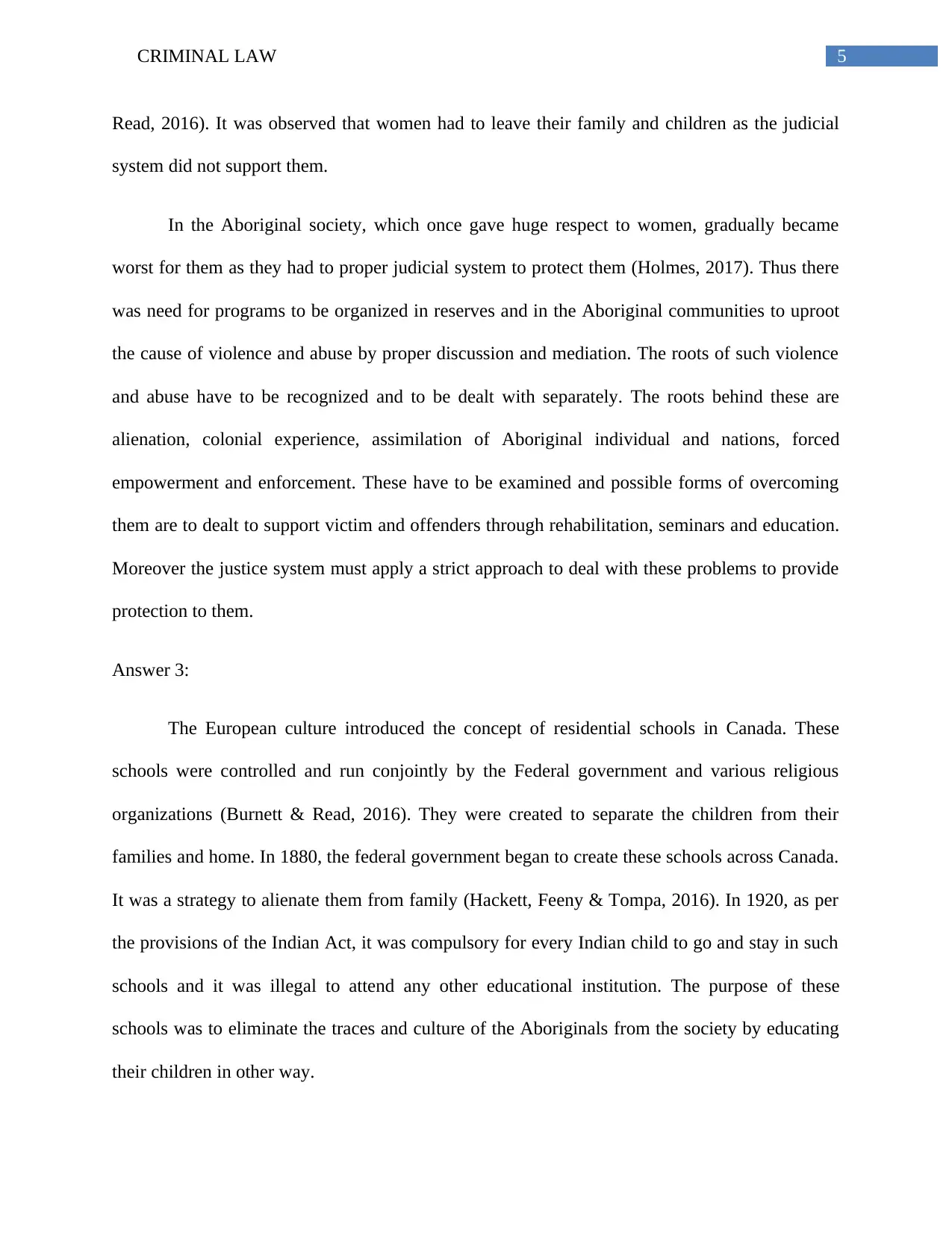
5CRIMINAL LAW
Read, 2016). It was observed that women had to leave their family and children as the judicial
system did not support them.
In the Aboriginal society, which once gave huge respect to women, gradually became
worst for them as they had to proper judicial system to protect them (Holmes, 2017). Thus there
was need for programs to be organized in reserves and in the Aboriginal communities to uproot
the cause of violence and abuse by proper discussion and mediation. The roots of such violence
and abuse have to be recognized and to be dealt with separately. The roots behind these are
alienation, colonial experience, assimilation of Aboriginal individual and nations, forced
empowerment and enforcement. These have to be examined and possible forms of overcoming
them are to dealt to support victim and offenders through rehabilitation, seminars and education.
Moreover the justice system must apply a strict approach to deal with these problems to provide
protection to them.
Answer 3:
The European culture introduced the concept of residential schools in Canada. These
schools were controlled and run conjointly by the Federal government and various religious
organizations (Burnett & Read, 2016). They were created to separate the children from their
families and home. In 1880, the federal government began to create these schools across Canada.
It was a strategy to alienate them from family (Hackett, Feeny & Tompa, 2016). In 1920, as per
the provisions of the Indian Act, it was compulsory for every Indian child to go and stay in such
schools and it was illegal to attend any other educational institution. The purpose of these
schools was to eliminate the traces and culture of the Aboriginals from the society by educating
their children in other way.
Read, 2016). It was observed that women had to leave their family and children as the judicial
system did not support them.
In the Aboriginal society, which once gave huge respect to women, gradually became
worst for them as they had to proper judicial system to protect them (Holmes, 2017). Thus there
was need for programs to be organized in reserves and in the Aboriginal communities to uproot
the cause of violence and abuse by proper discussion and mediation. The roots of such violence
and abuse have to be recognized and to be dealt with separately. The roots behind these are
alienation, colonial experience, assimilation of Aboriginal individual and nations, forced
empowerment and enforcement. These have to be examined and possible forms of overcoming
them are to dealt to support victim and offenders through rehabilitation, seminars and education.
Moreover the justice system must apply a strict approach to deal with these problems to provide
protection to them.
Answer 3:
The European culture introduced the concept of residential schools in Canada. These
schools were controlled and run conjointly by the Federal government and various religious
organizations (Burnett & Read, 2016). They were created to separate the children from their
families and home. In 1880, the federal government began to create these schools across Canada.
It was a strategy to alienate them from family (Hackett, Feeny & Tompa, 2016). In 1920, as per
the provisions of the Indian Act, it was compulsory for every Indian child to go and stay in such
schools and it was illegal to attend any other educational institution. The purpose of these
schools was to eliminate the traces and culture of the Aboriginals from the society by educating
their children in other way.
⊘ This is a preview!⊘
Do you want full access?
Subscribe today to unlock all pages.

Trusted by 1+ million students worldwide
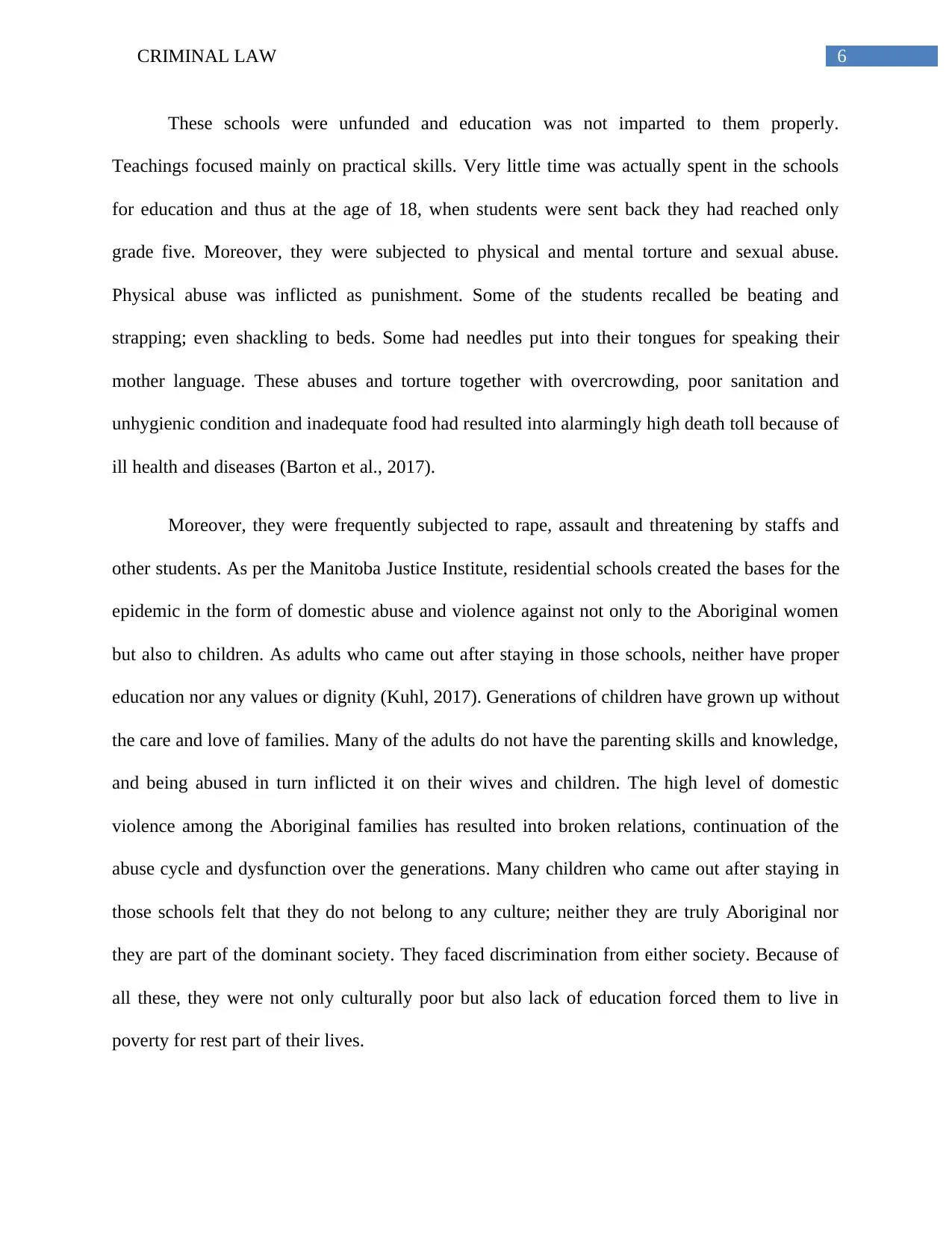
6CRIMINAL LAW
These schools were unfunded and education was not imparted to them properly.
Teachings focused mainly on practical skills. Very little time was actually spent in the schools
for education and thus at the age of 18, when students were sent back they had reached only
grade five. Moreover, they were subjected to physical and mental torture and sexual abuse.
Physical abuse was inflicted as punishment. Some of the students recalled be beating and
strapping; even shackling to beds. Some had needles put into their tongues for speaking their
mother language. These abuses and torture together with overcrowding, poor sanitation and
unhygienic condition and inadequate food had resulted into alarmingly high death toll because of
ill health and diseases (Barton et al., 2017).
Moreover, they were frequently subjected to rape, assault and threatening by staffs and
other students. As per the Manitoba Justice Institute, residential schools created the bases for the
epidemic in the form of domestic abuse and violence against not only to the Aboriginal women
but also to children. As adults who came out after staying in those schools, neither have proper
education nor any values or dignity (Kuhl, 2017). Generations of children have grown up without
the care and love of families. Many of the adults do not have the parenting skills and knowledge,
and being abused in turn inflicted it on their wives and children. The high level of domestic
violence among the Aboriginal families has resulted into broken relations, continuation of the
abuse cycle and dysfunction over the generations. Many children who came out after staying in
those schools felt that they do not belong to any culture; neither they are truly Aboriginal nor
they are part of the dominant society. They faced discrimination from either society. Because of
all these, they were not only culturally poor but also lack of education forced them to live in
poverty for rest part of their lives.
These schools were unfunded and education was not imparted to them properly.
Teachings focused mainly on practical skills. Very little time was actually spent in the schools
for education and thus at the age of 18, when students were sent back they had reached only
grade five. Moreover, they were subjected to physical and mental torture and sexual abuse.
Physical abuse was inflicted as punishment. Some of the students recalled be beating and
strapping; even shackling to beds. Some had needles put into their tongues for speaking their
mother language. These abuses and torture together with overcrowding, poor sanitation and
unhygienic condition and inadequate food had resulted into alarmingly high death toll because of
ill health and diseases (Barton et al., 2017).
Moreover, they were frequently subjected to rape, assault and threatening by staffs and
other students. As per the Manitoba Justice Institute, residential schools created the bases for the
epidemic in the form of domestic abuse and violence against not only to the Aboriginal women
but also to children. As adults who came out after staying in those schools, neither have proper
education nor any values or dignity (Kuhl, 2017). Generations of children have grown up without
the care and love of families. Many of the adults do not have the parenting skills and knowledge,
and being abused in turn inflicted it on their wives and children. The high level of domestic
violence among the Aboriginal families has resulted into broken relations, continuation of the
abuse cycle and dysfunction over the generations. Many children who came out after staying in
those schools felt that they do not belong to any culture; neither they are truly Aboriginal nor
they are part of the dominant society. They faced discrimination from either society. Because of
all these, they were not only culturally poor but also lack of education forced them to live in
poverty for rest part of their lives.
Paraphrase This Document
Need a fresh take? Get an instant paraphrase of this document with our AI Paraphraser
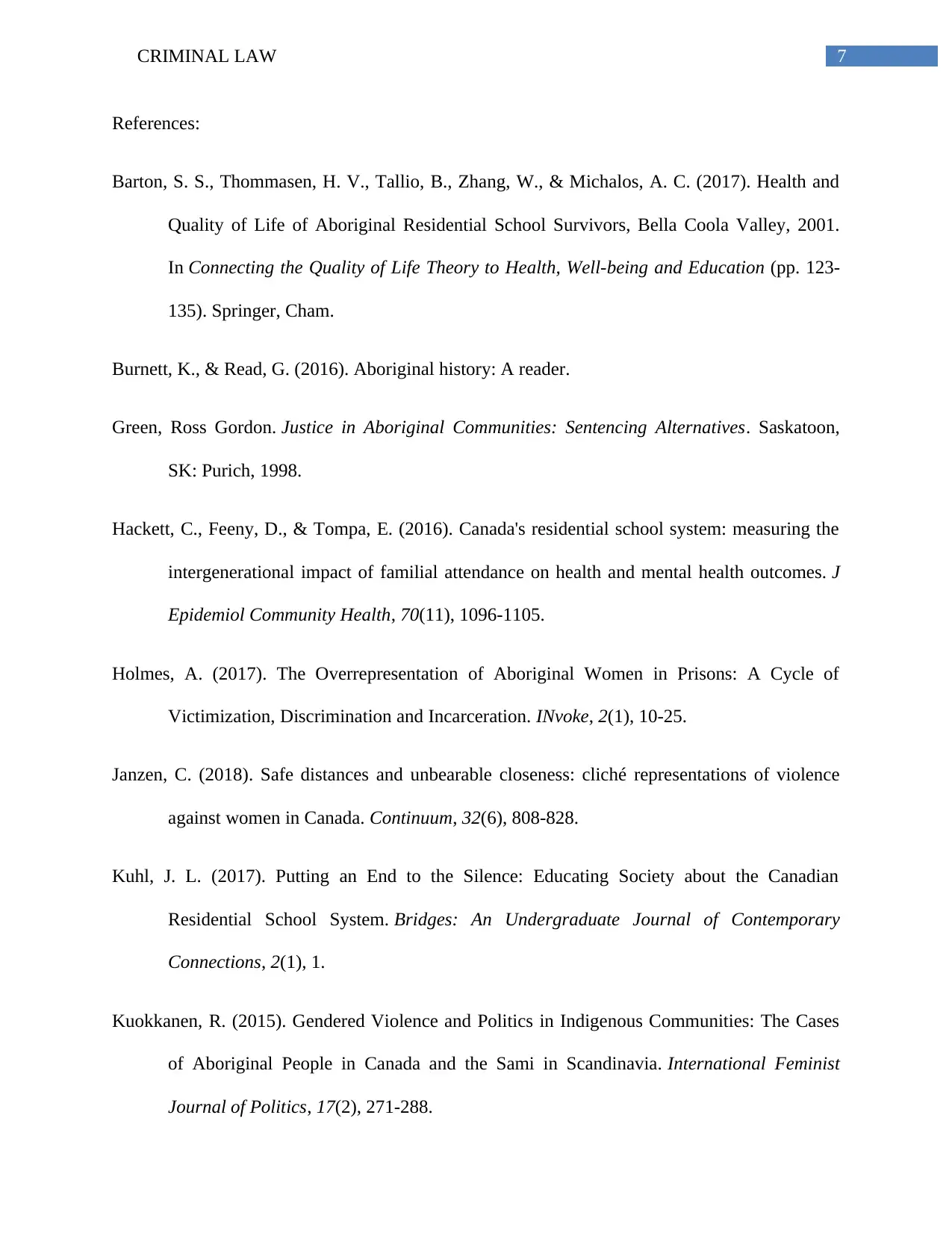
7CRIMINAL LAW
References:
Barton, S. S., Thommasen, H. V., Tallio, B., Zhang, W., & Michalos, A. C. (2017). Health and
Quality of Life of Aboriginal Residential School Survivors, Bella Coola Valley, 2001.
In Connecting the Quality of Life Theory to Health, Well-being and Education (pp. 123-
135). Springer, Cham.
Burnett, K., & Read, G. (2016). Aboriginal history: A reader.
Green, Ross Gordon. Justice in Aboriginal Communities: Sentencing Alternatives. Saskatoon,
SK: Purich, 1998.
Hackett, C., Feeny, D., & Tompa, E. (2016). Canada's residential school system: measuring the
intergenerational impact of familial attendance on health and mental health outcomes. J
Epidemiol Community Health, 70(11), 1096-1105.
Holmes, A. (2017). The Overrepresentation of Aboriginal Women in Prisons: A Cycle of
Victimization, Discrimination and Incarceration. INvoke, 2(1), 10-25.
Janzen, C. (2018). Safe distances and unbearable closeness: cliché representations of violence
against women in Canada. Continuum, 32(6), 808-828.
Kuhl, J. L. (2017). Putting an End to the Silence: Educating Society about the Canadian
Residential School System. Bridges: An Undergraduate Journal of Contemporary
Connections, 2(1), 1.
Kuokkanen, R. (2015). Gendered Violence and Politics in Indigenous Communities: The Cases
of Aboriginal People in Canada and the Sami in Scandinavia. International Feminist
Journal of Politics, 17(2), 271-288.
References:
Barton, S. S., Thommasen, H. V., Tallio, B., Zhang, W., & Michalos, A. C. (2017). Health and
Quality of Life of Aboriginal Residential School Survivors, Bella Coola Valley, 2001.
In Connecting the Quality of Life Theory to Health, Well-being and Education (pp. 123-
135). Springer, Cham.
Burnett, K., & Read, G. (2016). Aboriginal history: A reader.
Green, Ross Gordon. Justice in Aboriginal Communities: Sentencing Alternatives. Saskatoon,
SK: Purich, 1998.
Hackett, C., Feeny, D., & Tompa, E. (2016). Canada's residential school system: measuring the
intergenerational impact of familial attendance on health and mental health outcomes. J
Epidemiol Community Health, 70(11), 1096-1105.
Holmes, A. (2017). The Overrepresentation of Aboriginal Women in Prisons: A Cycle of
Victimization, Discrimination and Incarceration. INvoke, 2(1), 10-25.
Janzen, C. (2018). Safe distances and unbearable closeness: cliché representations of violence
against women in Canada. Continuum, 32(6), 808-828.
Kuhl, J. L. (2017). Putting an End to the Silence: Educating Society about the Canadian
Residential School System. Bridges: An Undergraduate Journal of Contemporary
Connections, 2(1), 1.
Kuokkanen, R. (2015). Gendered Violence and Politics in Indigenous Communities: The Cases
of Aboriginal People in Canada and the Sami in Scandinavia. International Feminist
Journal of Politics, 17(2), 271-288.
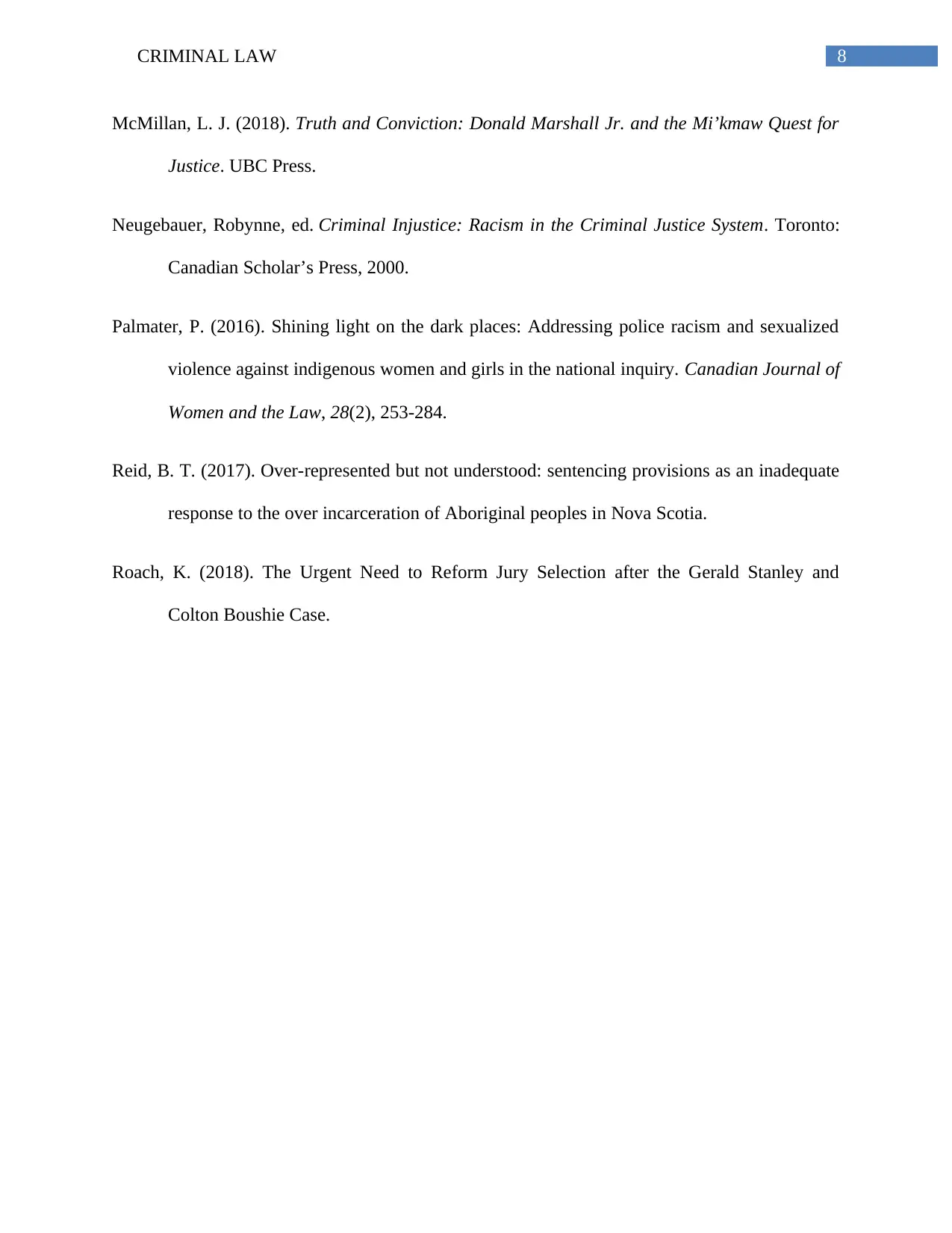
8CRIMINAL LAW
McMillan, L. J. (2018). Truth and Conviction: Donald Marshall Jr. and the Mi’kmaw Quest for
Justice. UBC Press.
Neugebauer, Robynne, ed. Criminal Injustice: Racism in the Criminal Justice System. Toronto:
Canadian Scholar’s Press, 2000.
Palmater, P. (2016). Shining light on the dark places: Addressing police racism and sexualized
violence against indigenous women and girls in the national inquiry. Canadian Journal of
Women and the Law, 28(2), 253-284.
Reid, B. T. (2017). Over-represented but not understood: sentencing provisions as an inadequate
response to the over incarceration of Aboriginal peoples in Nova Scotia.
Roach, K. (2018). The Urgent Need to Reform Jury Selection after the Gerald Stanley and
Colton Boushie Case.
McMillan, L. J. (2018). Truth and Conviction: Donald Marshall Jr. and the Mi’kmaw Quest for
Justice. UBC Press.
Neugebauer, Robynne, ed. Criminal Injustice: Racism in the Criminal Justice System. Toronto:
Canadian Scholar’s Press, 2000.
Palmater, P. (2016). Shining light on the dark places: Addressing police racism and sexualized
violence against indigenous women and girls in the national inquiry. Canadian Journal of
Women and the Law, 28(2), 253-284.
Reid, B. T. (2017). Over-represented but not understood: sentencing provisions as an inadequate
response to the over incarceration of Aboriginal peoples in Nova Scotia.
Roach, K. (2018). The Urgent Need to Reform Jury Selection after the Gerald Stanley and
Colton Boushie Case.
⊘ This is a preview!⊘
Do you want full access?
Subscribe today to unlock all pages.

Trusted by 1+ million students worldwide
1 out of 9
Related Documents
Your All-in-One AI-Powered Toolkit for Academic Success.
+13062052269
info@desklib.com
Available 24*7 on WhatsApp / Email
![[object Object]](/_next/static/media/star-bottom.7253800d.svg)
Unlock your academic potential
Copyright © 2020–2025 A2Z Services. All Rights Reserved. Developed and managed by ZUCOL.



